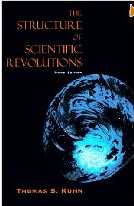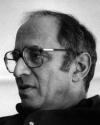The Structure of Scientific Revolutions (SSR) was originally printed as an article in the International Encyclopedia of Unified Science, published by the logical positivists of the Vienna Circle. In this book, Kuhn argued that science does not progress via a linear accumulation of new knowledge, but undergoes periodic revolutions, also called \"paradigm shifts\" (although he did not coin the phrase), in which the nature of scientific inquiry within a particular field is abruptly transformed. In general, science is broken up into three distinct stages. Prescience, which lacks a central paradigm, comes first. This is followed by \"normal science\", when scientists attempt to enlarge the central paradigm by \"puzzle-solving\". Thus, the failure of a result to conform to the paradigm is seen not as refuting the paradigm, but as the mistake of the researcher, contra Popper\'s refutability criterion. As anomalous results build up, science reaches a crisis, at which point a new paradigm, which subsumes the old results along with the anomalous results into one framework, is accepted. This is termed revolutionary science.
In SSR, Kuhn also argues that rival paradigms are incommensurable?that is, it is not possible to understand one paradigm through the conceptual framework and terminology of another rival paradigm. For many critics, for example David Stove (Popper and After, 1982), this thesis seemed to entail that theory choice is fundamentally irrational: if rival theories cannot be directly compared, then one cannot make a rational choice as to which one is better. Whether Kuhn\'s views had such relativistic consequences is the subject of much debate; Kuhn himself denied the accusation of relativism in the third edition of SSR, and sought to clarify his views to avoid further misinterpretation. Freeman Dyson has quoted Kuhn as saying \"I am not a Kuhnian!\", referring to the relativism that some philosophers have developed based on his work.
The enormous impact of Kuhn\'s work can be measured in the changes it brought about in the vocabulary of the philosophy of science: besides \"paradigm shift\", Kuhn raised the word \"paradigm\" itself from a term used in certain forms of linguistics to its current broader meaning, coined the term \"normal science\" to refer to the relatively routine, day-to-day work of scientists working within a paradigm, and was largely responsible for the use of the term \"scientific revolutions\" in the plural, taking place at widely different periods of time and in different disciplines, as opposed to a single \"Scientific Revolution\" in the late Renaissance. The frequent use of the phrase \"paradigm shift\" has made scientists more aware of and in many cases more receptive to paradigm changes, so that Kuhn?s analysis of the evolution of scientific views has by itself influenced that evolution.
Kuhn\'s work has been extensively used in social science; for instance, in the post-positivist/positivist debate within International Relations. Kuhn is credited as a foundational force behind the post-Mertonian Sociology of Scientific Knowledge.
A defense Kuhn gives against the objection that his account of science from The Structure of Scientific Revolutions results in relativism can be found in an essay by Kuhn called \"Objectivity, Value Judgment, and Theory Choice.\" In this essay, he reiterates five criteria from the penultimate chapter of SSR that determine (or help determine, more properly) theory choice:
- Accurate - empirically adequate with experimentation and observation
- Consistent - internally consistent, but also externally consistent with other theories
- Broad Scope - a theory\'s consequences should extend beyond that which it was initially designed to explain
- Simple - the simplest explanation, principally similar to Occam\'s Razor
- Fruitful - a theory should disclose new phenomena or new relationships among phenomena
He then goes on to show how, although these criteria admittedly determine theory choice, they are imprecise in practice and relative to individual scientists. According to Kuhn, \"When scientists must choose between competing theories, two men fully committed to the same list of criteria for choice may nevertheless reach different conclusions.\" For this reason, basically, the criteria still are not \"objective\" in the usual sense of the word because individual scientists reach different conclusions with the same criteria due to valuing one criterion over another or even adding additional criteria for selfish or other subjective reasons. Kuhn then goes on to say, \"I am suggesting, of course, that the criteria of choice with which I began function not as rules, which determine choice, but as values, which influence it.\" Because Kuhn utilizes the history of science in his account of science, his criteria or values for theory choice are often understood as descriptive normative rules (or more properly, values) of theory choice for the scientific community rather than prescriptive normative rules in the usual sense of the word \"criteria,\" although there are many varied interpretations of Kuhn\'s account of science. - Wikipedia (See also The Structure of Scientific Revolutions)
There\'s a \"Frank & Ernest\" comic strip showing a chick breaking out of its shell, looking around, and saying, \"Oh, wow! Paradigm shift!\" Blame the late Thomas Kuhn. Few indeed are the philosophers or historians influential enough to make it into the funny papers, but Kuhn is one.
The Structure of Scientific Revolutions is indeed a paradigmatic work in the history of science. Kuhn\'s use of terms such as \"paradigm shift\" and \"normal science,\" his ideas of how scientists move from disdain through doubt to acceptance of a new theory, his stress on social and psychological factors in science--all have had profound effects on historians, scientists, philosophers, critics, writers, business gurus, and even the cartoonist in the street.
Some scientists (such as Steven Weinberg and Ernst Mayr) are profoundly irritated by Kuhn, especially by the doubts he casts--or the way his work has been used to cast doubt--on the idea of scientific progress. Yet it has been said that the acceptance of plate tectonics in the 1960s, for instance, was sped by geologists\' reluctance to be on the downside of a paradigm shift. Even Weinberg has said that \"Structure has had a wider influence than any other book on the history of science.\" As one of Kuhn\'s obituaries noted, \"We all live in a post-Kuhnian age.\" --Mary Ellen Curtin
Thomas Kuhn (1922-1996) argued that scientific advancement is not evolutionary, but rather is a \"series of peaceful interludes punctuated by intellectually violent revolutions\", and in those revolutions \"one conceptual world view is replaced by another\". The University of Chicago Press has released The Structure Of Scientific Revolutions to the benefit of all students of the history of science, philosophy, and the impact of science on society (and society on the development of science). If every there were a true classic on the history and development of science that is \"must\" reading for each new generation, it is Kuhn\'s benchmark work, The Structure Of Scientific Revolutions. -- Midwest Book Review



